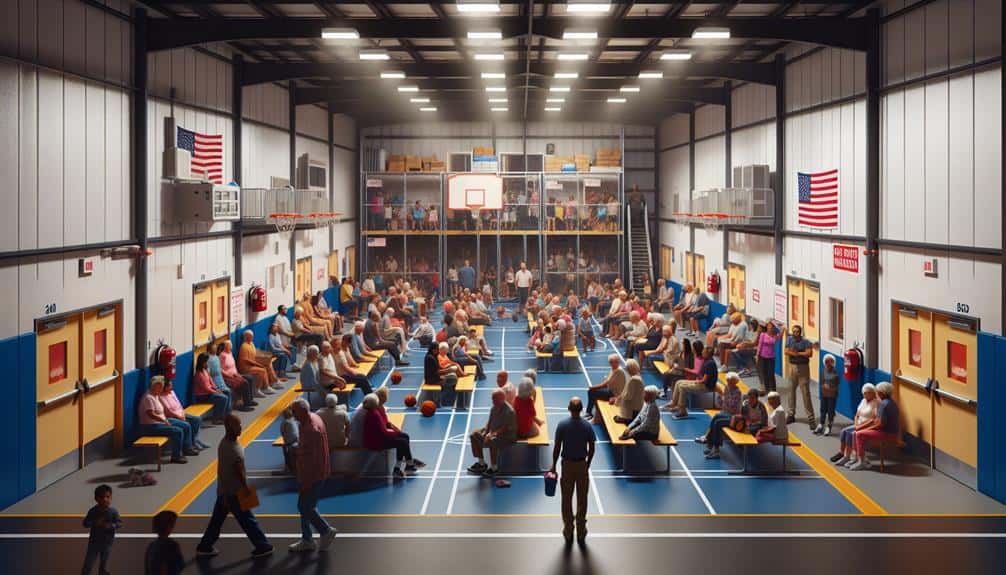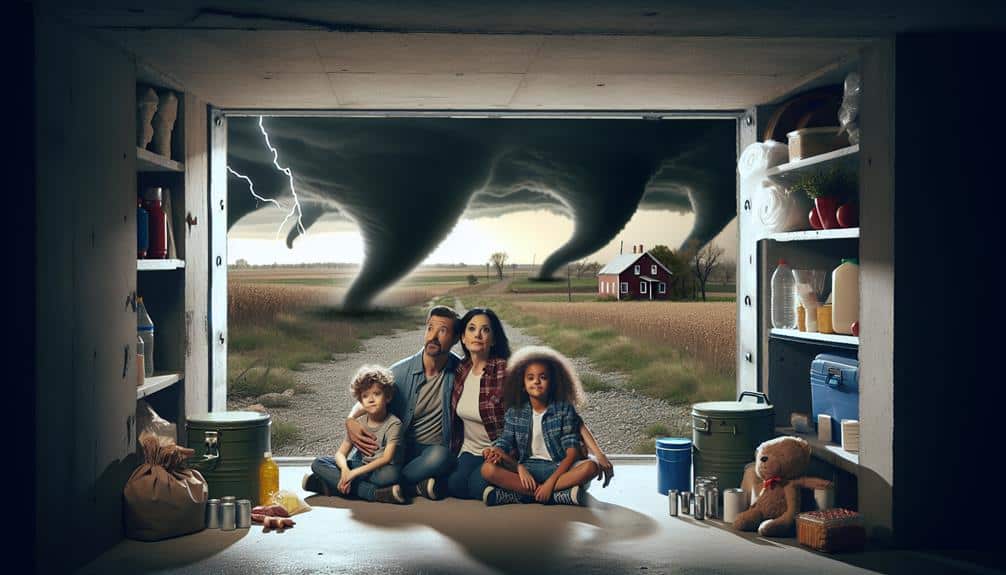We need dependable storm shelter options for our mobile homes, and the top choices include underground garages with reinforced walls, community storm shelters, and custom-built safe rooms using high-strength materials. Local fire stations and school gymnasiums often serve as designated storm shelters. Anchoring these shelters to concrete slabs and placing them in convenient locations enhances safety. Designated public buildings like community centers and municipal buildings also offer strong storm protection. Community support systems, including first aid kits and regular drills, further guarantee readiness. Continue to learn about the best practices and policies that can improve our storm readiness.
Key Points
- Community storm shelters enhance neighborhood preparedness and accessibility.
- School gymnasiums offer spacious, secure shelters with staff and emergency responders.
- Local fire stations designated as storm shelters provide strategic safety.
- Custom-built safe rooms with FEMA-standard materials ensure reinforced protection.
Underground Garages
Underground garages offer a strong and practical solution for mobile home residents seeking reliable storm shelters. By utilizing existing structures, we can transform these spaces into fortified safe havens. Retrofitting options include installing reinforced walls, ceiling supports, and secure entry points to withstand extreme weather conditions. This is crucial to ensuring that our shelter meets the highest safety regulations while keeping costs manageable.
When considering cost, it's crucial to weigh the expenses of retrofitting against the potential property damage risks. Investing in an underground garage conversion can save us significant financial and emotional hardship in the long run by protecting our homes and loved ones. Moreover, we should account for ongoing maintenance costs to guarantee the shelter remains in top condition.
Safety regulations must be strictly adhered to when converting an underground garage into a storm shelter. Compliance with these guidelines not only guarantees our safety but also minimizes liability risks. Proper ventilation, emergency exits, and durable construction materials are essential components of a compliant shelter.
In essence, transforming an underground garage into a storm shelter offers a cost-effective and secure solution, mitigating risks and ensuring peace of mind during severe weather events.
Community Storm Shelters
Community storm shelters provide a shared, reliable refuge for mobile home residents during severe weather events. These shelters are typically located within mobile home parks, guaranteeing that everyone has quick and easy access when the weather turns dangerous.
By utilizing these communal spaces, we can enhance our neighborhood storm preparedness and bolster our collective safety measures.
In many mobile home parks, community storm shelters are designed to accommodate a large number of residents, making them an essential part of any emergency plan. These shelters are built to withstand extreme weather conditions, providing a secure environment where we can ride out the storm with peace of mind.
They're often stocked with essential supplies like water, non-perishable food, and first aid kits, ensuring that we're well-prepared for any situation.
Effective neighborhood storm preparedness involves not only knowing the location of these shelters but also participating in regular emergency plan drills. By doing so, we can guarantee that everyone knows the fastest route to safety and understands the procedures to follow during an emergency.
Community storm shelters not only save lives but also foster a sense of unity and resilience among us, reinforcing the importance of looking out for one another.
Custom-Built Safe Rooms
Let's explore custom-built safe rooms, focusing on reinforced structural design and installation best practices.
We'll examine how to secure these rooms to withstand severe weather conditions.
Ensuring proper installation is essential for the safety of everyone in the mobile home.
Reinforced Structural Design
Constructing custom-built safe rooms with reinforced structural design offers mobile home residents a reliable solution for storm protection. When we talk about mobile home safety, one of the most critical aspects is ensuring that our safe rooms are designed to withstand severe weather conditions.
Reinforced structural design isn't just a buzzword; it's a necessity. By integrating structural reinforcement into our safe rooms, we can create a sanctuary that remains intact even during the most powerful storms. This involves using high-strength materials like concrete and steel, which provide superior resistance to wind, debris, and pressure changes.
We must also consider the importance of anchoring the safe room securely to the ground or the mobile home's frame, ensuring it doesn't shift or collapse. Moreover, the design should include proper ventilation and emergency exits to guarantee safety and accessibility.
Custom-built safe rooms allow us the flexibility to incorporate these critical features while tailoring the space to fit our specific needs and preferences. By prioritizing reinforced structural design, we can offer mobile home residents not just a shelter, but a fortress that stands strong when nature's fury strikes.
Installation Best Practices
When installing custom-built safe rooms in mobile homes, it's essential to follow best practices to guarantee maximum safety and durability.
First, let's focus on installation tips: always anchor the safe room to a concrete slab or a reinforced floor. This secures the structure remains stable during high winds and severe weather.
Next, adhere to safety guidelines by using materials that meet FEMA standards, such as steel or reinforced concrete. Make sure all components, including doors and ventilation systems, are rated to withstand extreme conditions. Position the safe room in an easily accessible location, ideally close to a central area in the mobile home.
Maintenance requirements are vital for the longevity and functionality of your safe room. Regularly inspect for any signs of wear, rust, or damage, and address these issues promptly. Keep the interior clean and free of clutter to guarantee you can quickly and safely reach the shelter during an emergency.
Local Fire Stations
Local fire stations often serve as designated storm shelters, providing a safe haven for mobile home residents during severe weather events. We should prioritize our emergency preparedness by familiarizing ourselves with these essential community resources. Fire stations are strategically located and equipped to handle disaster management, making them an ideal refuge when severe storms threaten our safety.
We can't underestimate the significance of knowing where our nearest fire station is and understanding its shelter protocols. These stations often have reinforced structures, emergency supplies, and trained personnel ready to offer assistance. Regularly reviewing safety tips and creating an emergency plan that includes the fire station as a potential shelter location can greatly enhance our readiness.
In addition to their primary role in firefighting, these stations act as community hubs during crises. They provide updated weather information and coordinate with other emergency services to guarantee thorough disaster management. By incorporating the local fire station into our emergency plans, we can leverage these community resources effectively.
Ultimately, taking advantage of the safety and resources offered by our local fire stations empowers us to make informed decisions during emergencies, ensuring that we and our loved ones remain secure and resilient in the face of severe weather.
School Gymnasiums

School gymnasiums often serve as important storm shelters, providing a spacious and secure environment for mobile home residents during severe weather. These facilities are designed to accommodate large groups, making them ideal for communities seeking refuge. Gymnasium safety is a top priority; these structures are built to withstand high winds and are often located away from flood-prone areas.
When we consider shelter capacity, school gymnasiums shine. They can hold hundreds of people, ensuring that almost everyone in the vicinity can find a safe spot during a storm. The open floor plan allows for flexible arrangements, accommodating families, individuals, and even pets with ease. We can spread out comfortably, reducing the stress and anxiety that often accompany severe weather events.
Additionally, school gymnasiums typically have emergency supplies and backup power sources, adding another layer of security. The presence of trained personnel, such as school staff and emergency responders, further enhances gymnasium safety. They're equipped to handle emergencies, providing medical assistance and maintaining order.
Designated Public Buildings
Let's focus on the designated public buildings that can serve as storm shelters for mobile home residents.
We should consider local community centers, school gymnasiums, and municipal buildings, all of which offer critical shelter options.
Each of these locations provides accessible, safe spaces during severe weather events.
Local Community Centers
Community centers often serve as designated public buildings equipped to provide safe storm shelters for mobile home residents. These centers are strategically located within communities, making them easily accessible during severe weather events. They're not just buildings; they're fortified safe havens designed to protect us when we need it most.
Inside, we'll find essential shelter resources like first aid kits, bottled water, and non-perishable food items. These resources guarantee that we can sustain ourselves during the critical hours of a storm.
Additionally, community centers follow strict emergency protocols. These protocols include procedures for registering and accounting for everyone, maintaining communication with local emergency services, and ensuring that all safety measures are in place.
Because community centers are public facilities, they're open to everyone, providing a sense of freedom and security. We don't need to worry about membership fees or restricted access. In times of crisis, these centers become our collective refuge, allowing us to weather the storm together.
School Gymnasiums Access
During severe weather events, gymnasiums in local schools often double as storm shelters, providing an important safe space for mobile home residents. School gymnasiums are well-suited for emergency response due to their large capacity, sturdy construction, and strategic locations within communities. When severe weather warnings are issued, we can rely on these facilities to open their doors and offer sanctuary to those in need.
School gymnasiums offer more than just physical shelter. They serve as a hub for community support, where neighbors can gather, share information, and assist each other during crises. The sense of solidarity that emerges in these spaces is invaluable, fostering a spirit of resilience and cooperation.
To guarantee a smooth emergency response, it's essential for us to familiarize ourselves with the nearest school gymnasiums designated as storm shelters. This means knowing the locations, understanding the access protocols, and being aware of the resources available on-site. In many cases, local authorities will provide guidance on which schools are equipped to serve as emergency shelters during specific types of weather events.
Municipal Buildings Availability
In addition to school gymnasiums, municipal buildings such as libraries, community centers, and town halls also serve as designated storm shelters for mobile home residents. These buildings are strategically chosen for their robust construction and ample shelter capacity. They're designed to withstand severe weather conditions and provide safe havens during emergencies.
Accessibility is a key factor when selecting these municipal buildings. They're typically centrally located, guaranteeing that residents can reach them quickly and safely. Many of these buildings are indeed equipped with ramps and other features to accommodate those with mobility issues, making them truly inclusive emergency shelters.
Our local governments have developed detailed location mapping to help us find the nearest municipal buildings quickly. This mapping is often available online and through various emergency response apps. This ensures that during a crisis, we can easily identify and navigate to the closest shelter without wasting precious time.
Emergency response teams regularly conduct drills and inspections at these municipal buildings to ensure they're ready for any eventuality. By prioritizing both shelter capacity and accessibility, these municipal buildings are an essential resource for mobile home residents seeking refuge during storms.
Frequently Asked Questions
How Do I Ensure My Mobile Home Is Properly Anchored During a Storm?
To guarantee our mobile home is properly anchored during a storm, we should conduct an anchor inspection, consider retrofit solutions, and follow best practices for mobile home safety and storm preparation. This secures our freedom and security.
What Are the Best Portable Storm Shelter Options for Mobile Homes?
For the best portable storm shelters, we should consider underground options like in-ground steel bunkers for maximum protection. Above ground options include reinforced steel or concrete shelters that can be easily installed next to our mobile home.
Are There Any Government Grants Available for Building Storm Shelters in Mobile Home Communities?
Yes, there are government grants available for building storm shelters. Grant eligibility often depends on community partnerships. Enhancing mobile home safety and weather preparedness can benefit from these programs aimed at protecting our communities.
How Can I Retrofit My Mobile Home to Improve Its Storm Resistance?
Remember the Smiths' mobile home surviving a tornado? They reinforced their roof and added window protection. We can retrofit our homes similarly to improve storm resistance, ensuring safety and freedom during severe weather.
What Emergency Supplies Should I Keep in My Storm Shelter?
In our storm shelter, we should stock food, water, a first aid kit, and a flashlight. These essentials make certain we're prepared for emergencies, providing the freedom to stay safe and self-sufficient until help arrives.


